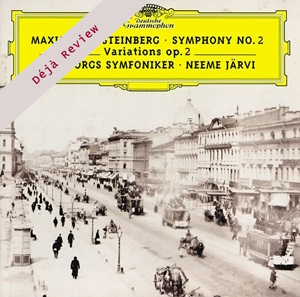
Déjà Review: this review was first published in May 2002 and the recording is still available.
Maximilian Steinberg (1883-1946)
Symphony No 2 (1909)
Variations for Orchestra (1905)
Göteborgs Symphony Orchestra / Neeme Järvi
rec. 1998, Göteborg Concert Hall, Gothenburg, Sweden
Deutsche Grammophon 471 198-2 [50]
In 1889 Vilnius-born Steinberg married the daughter of his composition professor at the St Petersburg Conservatoire. His professor was, of course, Rimsky-Korsakov. Rimsky died that same year and Steinberg was appointed to the Conservatoire staff. This rapid ascent rankled long and deep with Stravinsky, who had written his Feu d’Artifice to celebrate the wedding. Steinberg went on to create performing editions of the later Rimsky operas, as well as orchestral suites. In addition, in 1913, he completed and published Rimsky’s massively influential book, ‘The Principles of Orchestration’. He also in his own music remained faithful to Rimsky’s nationalist orchestral style.
There is nothing in the two works here to suggest Shostakovich who, with Yuri Shaporin and Georgy Rimsky-Korsakov (Nikolai’s nephew – the one who advocated quarter-tone music), were Steinberg’s pupils. The Symphony No 2 rises from deep Slavonic gloom into a toiling cauldron of Rimsky and Rachmaninov – principally the former. The music has some resonances with Rimsky’s Antar, Rachmaninov’s Isle of the Dead and early Miaskovsky. This is a torrid Russian symphony with lashings of atmosphere and, in the middle movement, some rasping and snarling brass. The woodwind writing may be equated with the brilliant scherzos of Glazunov; similarly in the finale of the 1905 Variations. It lacks ragingly distinctive themes, although there is plenty of imaginative oriental treatment and some great violin solos. In the finale, the horn writing has about it a touch of Franck’s Chasseur Maudit. This movement has more than its meed of gaunt moments, including, at the very end, the sense of the swinging to and fro of a colossal boulder-swung pendulum. Eisenstein would have loved it.
The Variations for Orchestra, of which there are nine, begin, naturally enough, with the Theme and end, equally naturally, with a Finale which is also marked ‘Variation X’. The Theme is all grace and smiling favour. The variations benevolently run the gamut through sunny Brahms, effervescent Dvořák, sturdily singing Schmidt (Husarenlied Variations) and brilliant Glazunov (the vivacious Var IV and the finale). As with the Symphony, there are no half-measures. Järvi directs a performance with the sort of brimming conviction you would expect to find in a performance of a Tchaikovsky or Borodin symphony.
The DG recording of the First Symphony would almost certainly be worth tracking down, and future instalments are worth watching out for. I know the 1932 Fourth Symphony, dubbed Turksib in honour of the pioneering feat of constructing the railway line joining Turkestan to Siberia, and it is a highly colourful affair. I do not mean to demean it when I describe it as tartly modernised Borodin. People may well have heard tapes of the BBC’s 1994 broadcast by the BBCPO and Alexander Vedernikov. The Fifth Symphony, from 1943, with its Uzbeki tunes and local instruments (like the much later symphonies by Terteryan), looks rather as if it were written in the same exile that produced folksy works from Prokofiev (String Quartet No 2) and Miaskovsky (Symphony No 23).
No doubt Symphonies Nos 3, 4 and 5 will follow over the next few years. If so, they are unlikely to find a more dedicated team than DG, Järvi and the orchestra at Göteborg.
By the way, Göteborg is the same place as Gothenburg and the orchestra is the same orchestra that also recorded Rachmaninov’s operatic triptych for Deutsche Grammophon.
Rob Barnett
Buying this recording via a link below generates revenue for MWI and helps us keep free access to the site


Also available:
Steinberg Symphony No 1, Göteborgs SO/Neeme Järvi, DG 457 607-2 Presto Music
















